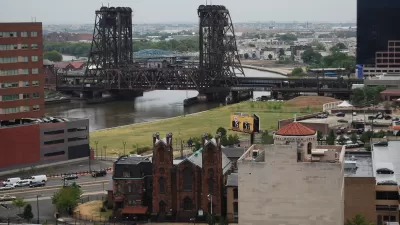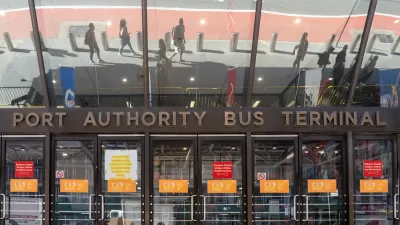A lack of a master plan for Port Newark is one of the reasons the city of Newark is looking to improve on the leadership of the Port Authority of New York and New Jersey.
"The city of Newark is dead serious about selling the land beneath Port Newark out from under the Port Authority," reports Paul Berger. That news came from Newark Deputy Mayor Baye Adofo-Wilson, who was on the defensive after reports that Mayor Ras Baraka told a town hall recently that "the city’s recent release of a formal document requesting expressions of interest in the port was a tactic to force the Port Authority to raise its lease payments to the city."
The political machinations over the Port of Newark are a big deal because the Port of Newark is a big deal: "Port Newark is one of the biggest operations at the Port of New York and New Jersey, which is itself the busiest port on the East Coast. In 2014, business at Newark accounted for about one-third of the port’s gross revenues and totaled $80 million." Newark owns the land under the Port, though it has leased the land to the Port Authority until 2065. Newark is hoping to start generating more than the $8 million per year the Port Authority pays to lease the land.
Deputy Mayor Adofo-Wilson is also quoted talking about how the port's lack of a master plan hinders its operations. In Adofo-Wilson's own words: "Without that master plan there’s no long term strategy for figuring out the best and most efficient use of the land and I think that’s what we want to start at…"
FULL STORY: Newark deputy mayor says city serious about selling land beneath Port Newark

Planetizen Federal Action Tracker
A weekly monitor of how Trump’s orders and actions are impacting planners and planning in America.

Congressman Proposes Bill to Rename DC Metro “Trump Train”
The Make Autorail Great Again Act would withhold federal funding to the system until the Washington Metropolitan Area Transit Authority (WMATA), rebrands as the Washington Metropolitan Authority for Greater Access (WMAGA).

The Simple Legislative Tool Transforming Vacant Downtowns
In California, Michigan and Georgia, an easy win is bringing dollars — and delight — back to city centers.

The States Losing Rural Delivery Rooms at an Alarming Pace
In some states, as few as 9% of rural hospitals still deliver babies. As a result, rising pre-term births, no adequate pre-term care and "harrowing" close calls are a growing reality.

The Small South Asian Republic Going all in on EVs
Thanks to one simple policy change less than five years ago, 65% of new cars in this Himalayan country are now electric.

DC Backpedals on Bike Lane Protection, Swaps Barriers for Paint
Citing aesthetic concerns, the city is removing the concrete barriers and flexposts that once separated Arizona Avenue cyclists from motor vehicles.
Urban Design for Planners 1: Software Tools
This six-course series explores essential urban design concepts using open source software and equips planners with the tools they need to participate fully in the urban design process.
Planning for Universal Design
Learn the tools for implementing Universal Design in planning regulations.
Smith Gee Studio
City of Charlotte
City of Camden Redevelopment Agency
City of Astoria
Transportation Research & Education Center (TREC) at Portland State University
US High Speed Rail Association
City of Camden Redevelopment Agency
Municipality of Princeton (NJ)




























